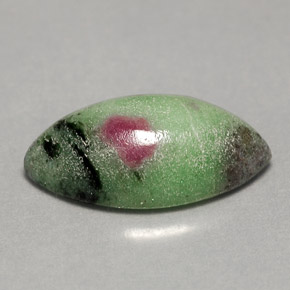The Gemstone Zoisite

Zoisite is a mineral that includes several gem varieties. The most important and well-known is Tanzanite, a sensational blue gemstone. The variety Thulite is used as a minor pink gemstone. A variety known as Ruby Zoisite, which is green Zoisite associated with opaque red Ruby (and often black amphibole streaks), is used as a carving gemstone as well as a minor gem. The term Zoisite is rarely used on its own in the gemstone trade.
Tanzanite and Thulite each have their own dedicated page.
Color
?
Blue, Red, Green, Pink, Purple
Chemical Formula
?
Ca
2Al
3(SiO
4)
3(OH)
Additional Properties
|
Refractive Index
?
1.69 - 1.70 |
Double Refraction
?
.009 |
Transparency
?
Opaque. May be translucent in thin backlit sections. |
SG
?
3.2 - 3.4 |
Luster
?
Vitreous |
| Cleavage ?
1,1 |
All About
Zoisite would not be of significant importance if not for the discovery of the transparent blue to purplish-blue variety that has been given the name
Tanzanite. This form of Zoisite is the main gem variety and has become increasingly popular and mainstream ever since its recent discovery.
The pink to red variety, called
Thulite, is an opaque
compact Zoisite formed from densely interlocking crystals. The opaque green variety, which is often found in association with
Ruby, was first discovered in Tanzania in 1954. This combination gemstone usually contains black
amphibole inclusions or veins, and its frequent association with red opaque Ruby give it a unique color and contrast. This combination is known as
Ruby Zoisite in the gem trade, and is occassionally also called
Anyolite.
Uses
?
Tanzanite is a very popular jewelry gemstone, faceted into all different gemstone cuts.
Thulite is an inexpensive stone used for
cabochons and beads. Green Zoisite and
Ruby Zoisite are also used as cabochons and beads, and are popular material for ornamental figures such as animal carvings.
Treatments & Enhancements
?
Tazanite is
heat treated to achieve the blue color. The other forms of Zoisite are naturally colored and usually not enhanced.
Zoisite Sources
?
The only source of Tanzanite is in the Merelani Hills of Arusha, Tanzania. Pink Thulite comes from Norway, Australia, and the U.S. (North Carolina). Green Zoisite and
Ruby Zoisite come from Longido, Tanzania.
Similar Gemstones
?
The purplish hue of
Tanzanite makes it somewhat unique. It is bluer then
Amethyst, though more purple then blue
Sapphire.
Thulite can resemble
Rhodonite. The green variety and
Ruby Zoisite are unique.
Zoisite Photos
?
This page only lists photos of Green Zoisite and
Ruby Zoisite. Images of
Tanzanite are listed on the dedicated Tanzanite page, and we currently don't have any photos of
Thulite.
Zoisite in the Rough Photos
?
This page only lists photos of Green Zoisite and
Ruby Zoisite. Images of
Tanzanite and
Thulite are listed separately on their own dedicated pages.